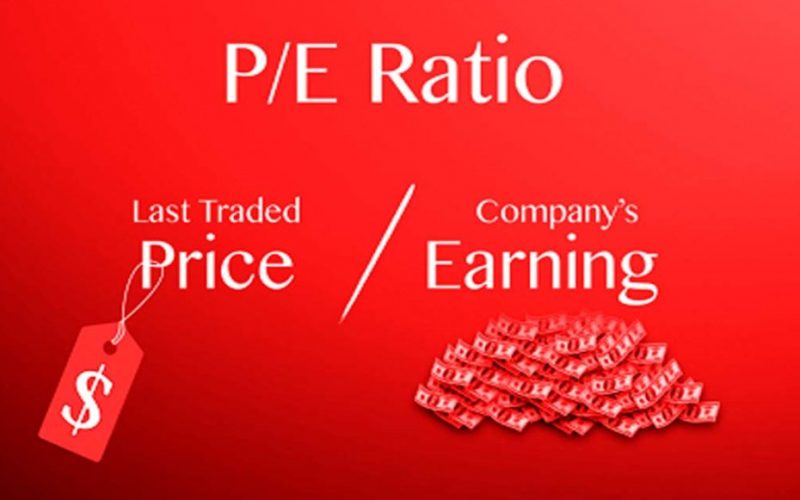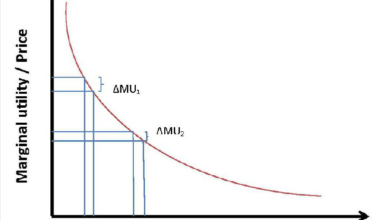The price-to-earnings ratio (P/E) is a popular statistic that investors and analysts use to determine company pricing. The P/E ratio can reflect how a firm’s valuation compares to its industry group or a benchmark like the S&P 500 index. Let’s learn more about the price earnings ratio, the formula and how it works in this article.
What is the Price-Earnings Ratio?
The Price Earnings Ratio (P/E Ratio) is the relationship that exists between a company’s stock price and earnings per share (EPS). It is a common ratio that provides investors with a better understanding of the company’s value. The P/E ratio reflects market expectations. Also, it is the price you must pay per unit of current earnings (or future earnings, as the case may be).
Earnings are crucial when determining the value of a company’s stock because investors want to know how lucrative a firm is and will be in the future. Furthermore, assuming the firm does not grow and its current earnings remain constant, the P/E ratio can be viewed as the number of years it will take the company to recoup the price paid for each share.
Read Also: Book-to-Market Ratio: Definition, Formula, and Calculations
How Price to Earnings Ratio Works
Looking at a stock’s P/E tells you virtually little about it until you compare it to the company’s historical P/E or the P/E of a competitor in the same industry. Without doing any comparisons, it is difficult to determine if a stock with a P/E of 10x is a steal or a stock with a P/E of 50x is overpriced.
The P/E ratio is useful because it standardizes stocks with varying prices and earnings levels.
The Price earnings ratio is also known as an earnings multiple. P/E is classified into two types: following and ahead. The former is based on prior periods’ earnings per share, whereas a leading or forward P/E ratio is when EPS computations are based on projected numbers (often provided by management or equity research analysts).
Formula for Price to Earnings Ratio
P/E = Stock Price Per Share / Earnings Per Share
or
P/E = Market Capitalization / Total Net Earnings
or
Justified P/E = Dividend Payout Ratio / R – G
where;
R denotes the required rate of return.
G denotes the rate of sustainable growth.
Explanation of the Price to Earnings Ratio Formula
The simple Price to Earnings ratio formula uses the current stock price and earnings per share to calculate the current P/E. Earnings from the previous twelve months are divided by the weighted average number of shares outstanding to calculate EPS. Earnings can be adjusted for unique or one-time things that have an abnormal influence on earnings.
The justified P/E ratio is used to calculate the P/E ratio that an investor should pay for based on the company’s dividend, retention policy, growth rate, and required rate of return. A frequent stock valuation strategy is to compare justified P/E to basic P/E.
Why Should You Use the Price-Earnings Ratio?
Investors prefer to invest in financially healthy companies that provide a good return on investment (ROI). Among the many ratios, we can use the P/E in the research process for stock selection. This is because it allows us to determine whether we are paying a reasonable price. Regardless of stock price, similar companies within the same industry are put together for comparison. Furthermore, it is quick and simple to utilize when attempting to assess a firm based on earnings. When we see a high or low P/E ratio, we can instantly determine what kind of stock or firm we’re working with.
High P/E ratio
Companies having a high price earnings ratio are frequently seen as growth companies. This means that future performance will be positive. Also, the investors have larger expectations for future earnings growth and are willing to pay more for it. The drawback is that growth stocks are frequently more volatile. Hence, they put a lot of pressure on companies to do more to justify their higher price. As a result, investing in growth stocks is more likely to be regarded as a risky venture. Stocks with high P/E ratios may also be overvalued.
Low P/E ratio
Companies having a low Price Earnings Ratio are sometimes regarded as value stocks. It suggests they are cheap because their stock price is lower in comparison to their fundamentals. This mispricing will be a wonderful deal for investors, prompting them to acquire the stock before the market corrects it. And when it does, investors profit because the stock price rises. Low P/E equities can be found in mature industries that provide consistent dividends.
Example of a Price to Earnings Ratio
Stock A is not inherently more costly than Stock B if it is trading at $30 while Stock B is trading at $20. From a value standpoint, the P/E ratio might assist us evaluate which of the two is less expensive.
Assume the sector’s average P/E is 15, and Stock A has a P/E of 15, and Stock B has a P/E of 30. Stock A is less expensive despite having a higher absolute price than Stock B. This is because you pay less for every $1 of current earnings. Stock B, on the other hand, has a higher ratio than both its competitor and the sector. This could imply that investors will anticipate better earnings growth in the future in comparison to the market.
The P/E ratio is simply one of valuation measurements and financial analysis tools that can help us make investing decisions. It should not be the only one.
Read Also: Financial Ratio Analysis: Detailed Guide to Interpretation of Financial Analysis
The benefits and drawbacks of utilizing the price-to-earnings ratio
Advantages of Using the P/E Ratio
Investors can assess whether a company’s shares are overpriced or underpriced. They can do this by comparing its price to earnings and deciding which stocks to buy. For the corporation, the P/E ratio is a good indicator of investor confidence in the business.
The disadvantages of utilizing the P/E ratio
The P/E ratio has limits as a measure of a company’s stock value. It should not be used as a single indicator of a company’s value. A price-to-earnings ratio is meaningless unless it is compared to the rest of the stocks in the same sector or other similar companies.
Price to Earnings Ratio Comparisons
Here are the finest P/E ratio comparisons to use:
#1. Peers
Competitors in an industry, for the most part, have similar firms and revenue patterns. That means that P/E ratios in the industry should be similar, with variances to the positive reflecting firm quality. If you believe a company has a superior business yet has a low P/E ratio, it could be an excellent investment.
#2. History
Examining a stock’s P/E ratio history is one of the best methods to avoid investing in stocks with consistently low P/E ratios. If a value stock’s price to earnings ratio has remained unfavorable for years, what is the unique catalyst that will cause it to trade at higher prices in the future? If a growth business is trading at its highest-ever P/E ratio, but its growth rate is slowing, the stock’s price may tumble soon.
So if a company is at the end of its life cycle and is still proving its business model, you can expect multiple expansions in the following years. It may be ready to accept a high P/E ratio. If a firm has a history of slow or no growth, be skeptical of multiple contractions and accept only low price to earnings ratios.
#3. Growth
Because a firm that is fast growing may be worth a high P/E ratio, you may compare ratios by calculating a company’s P/E ratio as a multiple of its predicted earnings growth rate. Simply divide a company’s price to earnings ratio by either the last few years’ earnings growth rate or an analyst-supplied prediction for the next few years. Companies with low P/E-to-earnings-growth ratios — say, less than one — may be worth slightly higher P/E ratios.
Price to Earnings Ratio FAQ’s
Is it better to have high or low Price to Earnings ratio?
A higher PE shows that the company has high hopes for future growth, either because it is small or operates in a fast-developing market. Others prefer a low PE because it indicates that expectations are not too high and that the company is more likely to outperform earnings estimates.
What is a good Price to earnings ratio for banks?
The major banks have a P/E ratio of 8.46, while the smaller regional banks have a P/E ratio of 13.50. 6 A mean or median average would indicate the banking industry’s average P/E ratio to be significantly more in line with usual market performance.
What is Amazon's Price to Earnings ratio?
Amazon.com has a trailing twelve-month P/E of 55.56X, while the Internet – Commerce industry has a P/E of 46.61X.
Related Articles
- FAIR VALUE ACCOUNTING: Definition & Benefits of Fair Value Accounting)
- Leverage Ratios: Definition, Types & Examples
- Financial Ratio Analysis: Detailed Guide to Interpretation of Financial Analysis
- Fortune 500: Definition, Techniques, & Factors for Ranking
- Credit Analysis: Guide to the Process & Ratios of Credit Analysis






